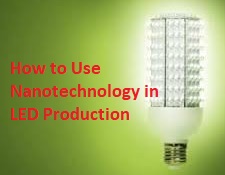 Hello readers welcome to New post. Here we will discuss How to Use Nanotechnology in LED Production. Nanotechnology is basically the handling of a story or several stories on a molecular scale. The idea for technology has been around since the 1960s, but much research and development began in the 1980’s. Its introduction in LED production brings high-level success in lighting solutions and displays.
Hello readers welcome to New post. Here we will discuss How to Use Nanotechnology in LED Production. Nanotechnology is basically the handling of a story or several stories on a molecular scale. The idea for technology has been around since the 1960s, but much research and development began in the 1980’s. Its introduction in LED production brings high-level success in lighting solutions and displays.
How to Use Nanotechnology in LED Production
LEDs are the most effective lighting solution in the market, because LEDs convert most of the energy into light. However, approximately 20% of the light emitted by the diode is lost due to the high LED indicator (a certain percentage of light is visible back inside the dice and does not emit at the end).
This measurement usually depends on the diode components. To find this lost light otherwise within the diode, researchers – and newly adopted manufacturers – used nanotechnology and made small holes (about 400 times smaller than human hair) on the surface of the diode, often in the hundreds of single diameter holes.
Since the introduction of Nano imprint technology in the process of building LEDs with nanotechnology it is cheaper and faster compared to previous solutions The so-called Nano LED is a very powerful and efficient LED solution, with a clear brightness. Also, without reducing light loss, the received light leads to less heat built up inside the duct. In this way, the LEDs can be packed next to each other, and have a normal life span. Another, additional advantage of Nano-LEDs is their high CRI, as well as wide range of color temperature.
The early use of technology was not even in lighting solutions but was shown on television, where nanotechnology has led to a new generation of LED TVs. The first LED televisions are not real LED solutions, in fact LCD TVs have LED lighting on the sides. With nanotechnology, LED TVs are created with multiple LEDs, behind a panel of small dots or nanoes that allow light to be emitted by LEDs. In this way the light disperses evenly, giving the image shown more meaning, clarity and smoothness. This technology also allows for smaller displays: the first technologically advanced TV is the LG LEX8, which is only 0.88 cm thin.

Nanotechnology is always bringing new exciting results. In the field of lighting, one of the latest news is the “nano-LEDs” that have grown like wires. The technology was accidentally discovered in September 2010, when chemists Babak Nikoobakht and Andrew Herzing tried to amplify the overhead cables. With the increased size of the gold catalyst, nanowires grow into “nanowall”, where electrons can flow. Charged electric wires produce light, which is why researchers dubbed the practice “nano-LED”. These technologies will allow adding light to smaller solutions, but their full range of capabilities has not been achieved.
Similarly the exciting success of nanotechnology in light could be solutions by Academia Sinica and National Cheng Kung University in Taiwan, where scientists applied gold nanoparticles to the leaves of trees, thus creating a bio-luminescent red light. These bio-LEDs require continuous improvement, but the goal is to create trees that provide street light to roads. It is thought that these trees can absorb CO2 at night, which is an additional level of photosynthesis.
Nanotechnology used to create other lighting solutions for the promising future in non-traditional types of lighting. Natural lighting or live lighting are both important approaches to eco-friendly lighting, making research at low cost and making LEDs more important.
LEDcentcentre.uk.com is a company that offers a wide range of low and high quality, efficient, efficient and cool LED lamps, such as car lights, LED GU10, LED MR11, LED MR16, -G4 LEDs and B22 / E27 flashlights and flexible fluorescent LED lights for homes, offices, shops, boats or caravan




